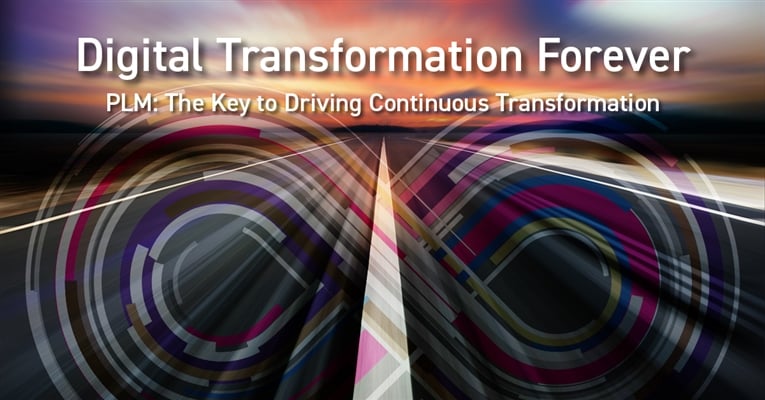Historically, companies have used digital transformation initiatives to change their business model to better meet the demands of their customers and achieve cost efficiency. Before the COVID-19 pandemic, it was not uncommon to spend hundreds of millions of dollars on digital transformation initiatives that resulted in a high percentage of well-documented failures.
I recently came across an interesting blog titled, The Top 10 Digital Transformation Failures of All Time, Selected by an ERP Expert Witness, and was particularly disturbed by the Haribo gummy bear failure. This blog is of course slanted toward a particular technology, ERP, but there are similar characteristics with digital transformation initiatives and major digitalization efforts that involve PLM. The larger issue at hand is that digital transformations themselves are transforming in a rapidly and ever-changing world.
The failures outlined in the blog mentioned above have a common theme—they are single initiatives. What’s missing is the fact that, as an outcome of the pandemic, companies must continuously change to make their business more resilient and agile. All businesses continuously transform in a good or bad way, whether they intend to or not, until they no longer exist. When you have a budget tied up in maintaining legacy IT infrastructure that can’t adapt to change, you are essentially waiting to get disrupted, and that’s no longer an option if you want to remain relevant and competitive.
The shift that is taking place is to more continuous, incremental transformations. One huge benefit to continuous transformation is that it reduces operational disruption, which is the largest risk for any digital transformation effort. There is nothing wrong with incremental change. Incremental change lowers the risk of failure by demonstrating a better Return on Investment (ROI) and Time to Value (TTV). Additionally, smaller, more frequent successes convince people to adopt and contribute to a culture of continuous change.
The pandemic turned transformational efforts away from large, 100 million dollar+ transformations and opened the door for the ability to execute many digitalization efforts and digital transformations focused on making companies more collaborative, agile, and resilient, while using less people and less budget.
Specifically, the pandemic forced a shift from in-person collaboration to digital collaboration. This could be related to any number of factors impacting your business, such as growing complexity of products, a remote and global workforce, supply chain flexibility, improved quality, better reuse of design data, digital threads, digital twins, a move to the cloud, a shift to products-as-a-service, more pervasive change management, regulatory compliance, better security, and improved time-to-market. Regardless of which areas you choose to improve, you will need to improve how you communicate across your product ecosystem for it to be successful.
In IDC’s Product and Innovation Survey 2021[1] , 800 manufacturing executives were asked, “When they do collaborate, how do engineering, manufacturing, and service collaborate?” The top response, which over 50% of respondents chose, was through a digital collaboration platform (i.e., Zoom, Microsoft Teams, Google). This was not surprising to me. The second most popular response, with just under 50%, was a PLM system.
While it’s true we’re experiencing a resurgence in PLM, it can’t be your grand pappy’s PLM system. Rigid and inflexible PLM software won’t cut it moving forward. You can no longer spend millions to customize it, only to get stuck on an unsustainable release. You can’t expect those same unappreciative engineers to use older technology without secure in-context collaboration with manufacturing and service. The future demands that PLM be built on a resilient platform, or as Gartner, IDC, and CIMdata have defined it - a Product Innovation Platform. A Product Innovation Platform offers the ability to configure, customize, and build applications the PLM provider doesn’t have – all while staying upgraded.
Let me be clear, this is not an Out-of-the Box (OOTB) solution. Customizations are not riskier or more costly if the platform provides guaranteed upgrades, which are in fact the greatest means to adapt and optimize your PLM system. I interviewed Tech-Clarity’s James White, and in a recent webinar and eBook, he made the point that OOTB is a fallacy and most companies prioritize PLM functionality and the “what’s right for me” experience.
A successful Product Innovation Platform is not a portfolio of products without an end-to-end digital thread. It’s also not one without digital twins—an accurate, up-to-date replica of your assets in the field. It is one that enables you to collaborate across your enterprise with different types of data. It enables you to customize PLM applications, build industrial grade applications on the platform, and run it securely with performance and scalability from the cloud. Furthermore, it should provide you with the option to have it hosted as a SaaS offering – with upgrades, including customizations, on your schedule.
Industry ecosystems are now the top focus for manufacturers. This is causing companies to move toward PLM providers who offer a digital transformation platform that increases flexibility and resiliency across the enterprise. Companies today must have the ability to increase their capability, knowledge, and collaboration so they can adapt and execute most efficiently, regardless of the future disruptions they may face.
[1] IDC, Product and Service Innovation Survey Report, Doc # US46592621, July 2021

